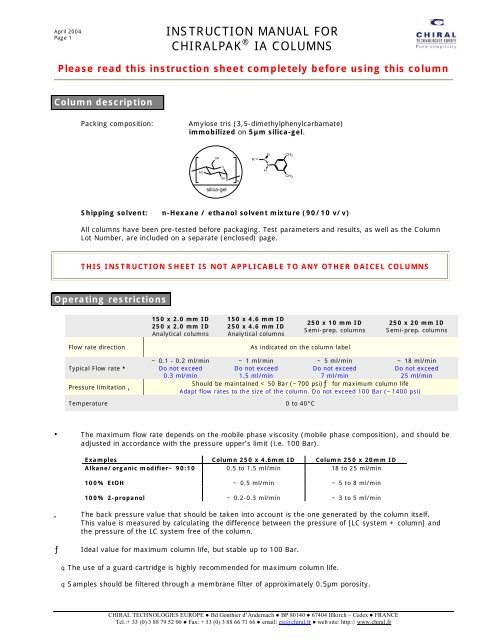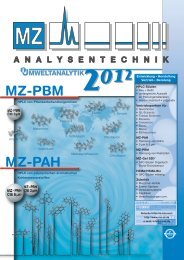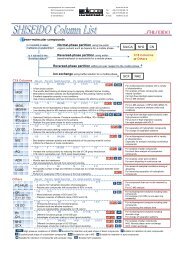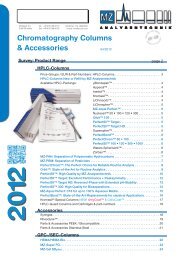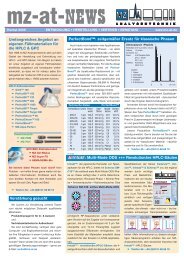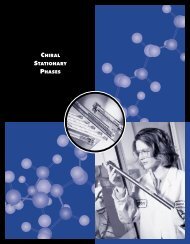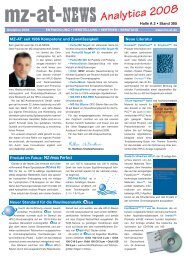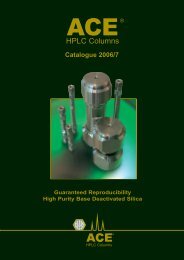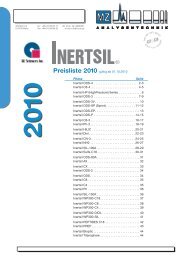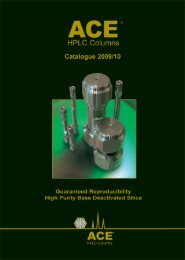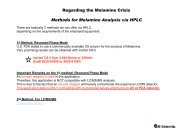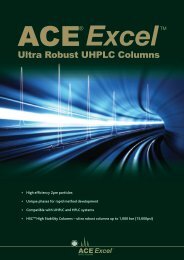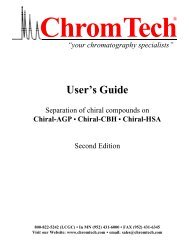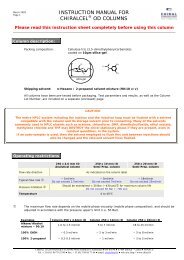Column cleaning and regeneration procedures
Column cleaning and regeneration procedures
Column cleaning and regeneration procedures
Create successful ePaper yourself
Turn your PDF publications into a flip-book with our unique Google optimized e-Paper software.
April 2004<br />
Page 1<br />
Please read this instruction sheet completely before using this column<br />
<strong>Column</strong> description<br />
Packing composition: Amylose tris (3,5-dimethylphenylcarbamate)<br />
immobilized on 5µm silica-gel.<br />
RO<br />
OR<br />
O<br />
OR<br />
O<br />
silica-gel<br />
Shipping solvent: n-Hexane / ethanol solvent mixture (90/10 v/v)<br />
n<br />
All columns have been pre-tested before packaging. Test parameters <strong>and</strong> results, as well as the <strong>Column</strong><br />
Lot Number, are included on a separate (enclosed) page.<br />
THIS INSTRUCTION SHEET IS NOT APPLICABLE TO ANY OTHER DAICEL COLUMNS<br />
Operating restrictions<br />
150 x 2.0 mm ID<br />
250 x 2.0 mm ID<br />
Analytical columns<br />
150 x 4.6 mm ID<br />
250 x 4.6 mm ID<br />
Analytical columns<br />
250 x 10 mm ID<br />
Semi-prep. columns<br />
Flow rate direction As indicated on the column label<br />
Typical Flow rate<br />
Pressure limitation<br />
INSTRUCTION MANUAL FOR<br />
CHIRALPAK ® IA COLUMNS<br />
~ 0.1 - 0.2 ml/min<br />
Do not exceed<br />
0.3 ml/min<br />
O CH3 C<br />
N<br />
H<br />
~ 1 ml/min<br />
Do not exceed<br />
1.5 ml/min<br />
~ 5 ml/min<br />
Do not exceed<br />
7 ml/min<br />
CHIRAL TECHNOLOGIES EUROPE ● Bd Gonthier d’Andernach ● BP 80140 ● 67404 Illkirch – Cedex ● FRANCE<br />
Tel.:+ 33 (0) 3 88 79 52 00 ● Fax: + 33 (0) 3 88 66 71 66 ● email: cte@chiral.fr ● web site: http:// www.chiral.fr<br />
250 x 20 mm ID<br />
Semi-prep. columns<br />
~ 18 ml/min<br />
Do not exceed<br />
25 ml/min<br />
Should be maintained < 50 Bar (~700 psi) for maximum column life<br />
Adapt flow rates to the size of the column. Do not exceed 100 Bar (~1400 psi)<br />
Temperature 0 to 40°C<br />
The maximum flow rate depends on the mobile phase viscosity (mobile phase composition), <strong>and</strong> should be<br />
adjusted in accordance with the pressure upper’s limit (i.e. 100 Bar).<br />
Examples <strong>Column</strong> 250 x 4.6mm ID <strong>Column</strong> 250 x 20mm ID<br />
Alkane/organic modifier~ 90:10 0.5 to 1.5 ml/min 18 to 25 ml/min<br />
100% EtOH ~ 0.5 ml/min ~ 5 to 8 ml/min<br />
100% 2-propanol ~ 0.2-0.3 ml/min ~ 3 to 5 ml/min<br />
The back pressure value that should be taken into account is the one generated by the column itself.<br />
This value is measured by calculating the difference between the pressure of [LC system + column] <strong>and</strong><br />
the pressure of the LC system free of the column.<br />
Ideal value for maximum column life, but stable up to 100 Bar.<br />
q The use of a guard cartridge is highly recommended for maximum column life.<br />
q Samples should be filtered through a membrane filter of approximately 0.5µm porosity.<br />
R =<br />
CH3
April 2004<br />
Page 2<br />
Operating procedure<br />
A - Mobile phases<br />
CHIRALPAK ® IA allows free choice of any miscible solvents to compose the mobile phase. The column can be used<br />
with all ranges of organic miscible solvents, progressing from the traditional mobile phases used with other Daicel<br />
columns (mixtures of alkanes/alcohol, pure alcohol or acetonitrile) to mobile phases containing ethyl acetate,<br />
tetrahydrofurane (THF), methyl tert-butyl ether (MtBE), dichloromethane (CH2Cl2) <strong>and</strong> chloroform(CHCl3), among<br />
others.<br />
Two groups of solvents can be identified with regards to CHIRALPAK ® IA:<br />
• Group A: st<strong>and</strong>ard solvents commonly used for coated-type polysaccharide-derived columns.<br />
• Group B: extended solvent range.<br />
In the following tables some guidelines will be given in order to assist the user in the method development. In<br />
Table 1 several solvent mixtures of both groups are described, together with the typical starting conditions <strong>and</strong><br />
advised optimisation ranges. Solvents are arranged according to their eluting strength. Toluene, MtBE <strong>and</strong><br />
chlorinated solvents can be used in their pure form in the mobile phase. For fast eluting solvents, such as THF,<br />
1,4-dioxane or acetone, we recommend to be used in combination with solvents of group A (especially alkanes) in<br />
order to modulate the retention. In Table 2 the solvent mixtures of group A are shown following the same criteria<br />
as in Table 1. Extreme pH ranges must be avoided because they can damage the silica gel used in this column.<br />
Group B solvents<br />
Table 1. Typical mobile phases containing solvents of group A <strong>and</strong> B<br />
MtBE CHCl3 CH2Cl2 Ethyl acetate THF 1,4-Dioxane Acetone<br />
Group A solvents Ethanol Alkane Alkane Alkane Alkane Alkane Alkane<br />
Typical starting<br />
conditions<br />
(solvent B/solvent A)<br />
98:2 60:40 50:50 40:60 30:70 25:75 25:75<br />
80:20 25:75 25:75 20:80 10:90 10:90 10:90<br />
Advised optimisation<br />
range<br />
to<br />
to<br />
to<br />
to<br />
to<br />
to<br />
to<br />
100:0 100:0 100:0 70:30 50:50 40:60 40:60<br />
Some solvents such as MtBE, CHCl3 or CH2Cl2 may need the combination with alcohols (usually 1-5%) to modulate retention times <strong>and</strong> improve<br />
peak shape.<br />
Organic modifiers in MtBE can also be: 2-propanol, methanol, THF, ethyl acetate, methyl acetate, 1,4-dioxane or acetone.<br />
Alkane: n-hexane, iso-hexane or n-heptane. Some small selectivity differences may sometimes be found.<br />
Group A solvent<br />
mixtures<br />
Typical starting<br />
conditions<br />
Advised<br />
optimisation range<br />
Table 2. Typical mobile phases containing solvents of group A<br />
Ethanol Methanol Acetonitrile alkane / EtOH<br />
Alkane /<br />
2-PrOH<br />
CHIRAL TECHNOLOGIES EUROPE ● Bd Gonthier d’Andernach ● BP 80140 ● 67404 Illkirch – Cedex ● FRANCE<br />
Tel.:+ 33 (0) 3 88 79 52 00 ● Fax: + 33 (0) 3 88 66 71 66 ● email: cte@chiral.fr ● web site: http:// www.chiral.fr<br />
Alkane /<br />
MeOH<br />
100 100 100 90:10 90:10 95:5<br />
100-50% in<br />
MeOH, 2-PrOH<br />
or ACN<br />
100-50% in<br />
EtOH, 2-PrOH<br />
or ACN<br />
100-80% in<br />
MeOH, EtOH<br />
or 2-PrOH<br />
99:1<br />
to<br />
50:50<br />
99:1<br />
to<br />
50:50<br />
99:1<br />
to<br />
50:25:25<br />
Certain alcohol mixtures have a higher viscosity. Pressure should be controlled <strong>and</strong> flow rate reduced if necessary.<br />
The retention is generally shorter with a higher alcohol content. The use of other alcohols such as 1-propanol, 1-BuOH, 2-BuOH etc…is possible.<br />
No range limitation, but due to miscibility restrictions, mix methanol with an equal volume of ethanol when using with alkane mixtures,<br />
otherwise, separation of liquid phases might happen. A maximum of 5% methanol in n-hexane may be used without adding ethanol.<br />
Based on our extensive experience the above mentioned solvents <strong>and</strong> their mixtures can be classified in two<br />
groups in terms of enantioselectivity. However, the separation ability of the chiral support may be different<br />
depending on the sample.<br />
Alcohols, THF, MtBE, CH2Cl2 > Ethyl acetate, acetonitrile, CHCl3, toluene, 1,4-dioxane, acetone
April 2004<br />
Page 3<br />
We would recommend THF, MtBE, dichloromethane or alcohols (pure or in alkane mixtures) to begin the<br />
development of an analytical method . The solvent leading to a higher solubility of your sample will be the first<br />
choice when this is a limiting factor.<br />
Detection with a regular UV detector may become difficult depending on a combination of sample <strong>and</strong> mobile phase (e.g. acetone, ethyl acetate,<br />
toluene, high percentages of chloroform). In those cases an alternative detector, such as RI detector or ELSD (Evaporative Light Scattering<br />
Detector), may be more effective than the UV.<br />
B – Additives<br />
For basic or acidic samples, it is<br />
necessary to incorporate an additive<br />
into the mobile phase in order to<br />
optimize the chiral separation:<br />
For primary amines mainly<br />
For primary amino alcohols mainly<br />
Basic Samples<br />
require<br />
Basic additives<br />
DEA<br />
Butyl amine<br />
Ethanol amine<br />
< 0.5%<br />
Typically 0.1%<br />
STRONGLY BASIC solvent additives or sample solutions MUST BE AVOIDED, because they are likely to damage the silica gel<br />
used in this column.<br />
<strong>Column</strong> care / Maintenance<br />
F <strong>Column</strong> <strong>cleaning</strong> <strong>and</strong> <strong>regeneration</strong> <strong>procedures</strong><br />
Chiral recognition of polysaccharide type phases also depends on the supramolecular structure of the<br />
polymeric chiral selector. The molecular conformation can change in different solvating environments. In order<br />
to ensure consistent performances after extensive use with different mobile phases, a <strong>regeneration</strong> method<br />
may be necessary to eliminate any unexpected change of chiral recognition due to the history of the column<br />
(mobile phases, additives,…).<br />
• Flush with ethanol (0.5 ml/min for 30 min) followed by 100% THF at 0.5 ml/min for 2 hours.<br />
• Flush with ethanol (0.5 ml/min for 30 min) <strong>and</strong> then equilibrate with alkane / ethanol = 80 / 20 (v/v)<br />
prior to retesting the column.<br />
If this is not successful, then try with 100% N,N-dimethylformamide or N,N-dimethylacetamide at 0.3 ml/min<br />
for 3 hours instead of the THF flush.<br />
<strong>Column</strong> storage<br />
q Ethanol can be used as universal storage solvents. However, if you are working with alkane containing mobile<br />
phases, the column can be kept in n-hexane / ethanol 90/10 when stored for more than one week.<br />
q For columns used with acidic or basic additives, flush the column with the same mobile phase without the<br />
modifier before storage.<br />
Operating this column in accordance with the guidelines outlined here will result in a long column life.<br />
Solvent effects on CHIRALPAK ® IA separations<br />
methaqualone<br />
methaqualone<br />
O<br />
N<br />
N<br />
CH 3<br />
CH 3<br />
CHIRALPAK ® IA<br />
n-hexane/CH<br />
hexane/CH2 Cl Cl2 75:25<br />
CHIRALPAK α= = 2.36<br />
Rs = 25.1<br />
® IA<br />
n-hexane/CH<br />
hexane/CH2 Cl Cl2 75:25<br />
α= = 2.36<br />
Rs = 25.1<br />
0 10 20 min<br />
Acidic Samples<br />
require<br />
Acidic additives<br />
TFA<br />
CH3COOH<br />
HCOOH<br />
< 0.5%<br />
Typically 0.1%<br />
Separation examples for racemic methaqualone on CHIRALPAK ® IA<br />
(25 x 0.46 cm, 25°C)<br />
Mobile phase k’1 a Rs<br />
n-hexane/2-propanol 80:20 1.45 1.65 7.08<br />
n-hexane/methyl acetate 80:20 1.87 1.70 9.45<br />
n-hexane/chloroform 50:50 0.64 1.79 7.84<br />
n-hexane/dichloromethane 75:25 2.90 2.36 25.1<br />
n-hexane/acetone 85:15 1.42 1.33 5.82<br />
n-hexane/tetrahydrofuran 85:15 3.14 1.63 11.3<br />
methyl tert-butyl ether/ethanol 95:5 0.73 2.81 13.1<br />
toluene/n-hexane/ethanol 70:25:5 0.54 1.96 9.28<br />
CHIRAL TECHNOLOGIES EUROPE ● Bd Gonthier d’Andernach ● BP 80140 ● 67404 Illkirch – Cedex ● FRANCE<br />
Tel.:+ 33 (0) 3 88 79 52 00 ● Fax: + 33 (0) 3 88 66 71 66 ● email: cte@chiral.fr ● web site: http:// www.chiral.fr
April 2004<br />
Page 4<br />
40<br />
30<br />
20<br />
10<br />
0<br />
Hexobarbital<br />
Hexobarbital<br />
O N<br />
0 1 2 3 4 5 6 7 8 9<br />
Minutes<br />
0.8<br />
0.7<br />
0.6<br />
0.5<br />
0.4<br />
0.3<br />
0.2<br />
0.1<br />
0.0<br />
300<br />
250<br />
200<br />
150<br />
100<br />
50<br />
0<br />
100% methyl methyl tert-butyl tert butyl ether<br />
ether<br />
k 1’ ’ = = 0.31<br />
0.31<br />
α= α= α= = 2.94<br />
2.94<br />
Rs = = 7.46<br />
7.46<br />
O<br />
N<br />
OH<br />
Detection Detection: Detection Detection: Detection Detection: : UV UV 230 230 nm<br />
nm<br />
N<br />
O<br />
n-hexane/THF/DEA<br />
hexane/THF/DEA<br />
90:10:0.1<br />
k 1’ ’ = = 3.94<br />
3.94<br />
α= = 1.55<br />
1.55<br />
Rs = = 8.20 8.20<br />
Bupivacaine<br />
N<br />
H<br />
Detection Detection: Detection Detection: Detection Detection: : ELSD<br />
ELSD<br />
0 5 10 15 20 25 30 35<br />
Minutes<br />
n-hexane/CH<br />
hexane/CH 2Cl Cl 2/2 /2-PrOH PrOH/TFA /TFA<br />
35:65:1:0.1<br />
35:65:1:0.1<br />
35:65:1:0.1<br />
35:65:1:0.1<br />
35:65:1:0.1<br />
35:65:1:0.1<br />
k 1’ ’ = 2.89<br />
2.89 2.89<br />
α= = 1.18<br />
1.18 1.18 1.18<br />
Naproxen<br />
Naproxen<br />
Rs = = 2.59<br />
2.59 2.59<br />
Detection Detection: Detection Detection: Detection Detection: : UV UV 254 254 nm<br />
nm<br />
0 2 4 6 8 10 12 14 16 18 20<br />
Minutes<br />
O<br />
O<br />
OH<br />
n-hexane/ hexane/acetone acetone<br />
60:40<br />
k 1’ ’ = 1.75<br />
1.75<br />
α= a = 1.47<br />
Rs = = 7.97<br />
Detection Detection: Detection Detection: Detection Detection: : ELSD<br />
ELSD<br />
0 2 4 6 8 10 12 14 16 18<br />
Minutes<br />
General conditions: CHIRALPAK ® IA 25 x 0.46 cm, Flow rate: 1 ml/min, 25°C<br />
If you have any questions about the use of this column, or encounter a problem, please contact<br />
CHIRAL TECHNOLOGIES EUROPE for assistance (cte@chiral.fr).<br />
For more detailed information about this column <strong>and</strong> other Daicel supports, refer to our catalogue also available on<br />
our website: http://www.chiral.fr or contact CHIRAL TECHNOLOGIES EUROPE.<br />
CHIRALCEL ® , CHIRALPAK ® <strong>and</strong> CROWNPAK ® are registered trademarks of<br />
DAICEL CHEMICAL INDUSTRIES LTD<br />
CHIRAL TECHNOLOGIES EUROPE ● Bd Gonthier d’Andernach ● BP 80140 ● 67404 Illkirch – Cedex ● FRANCE<br />
Tel.:+ 33 (0) 3 88 79 52 00 ● Fax: + 33 (0) 3 88 66 71 66 ● email: cte@chiral.fr ● web site: http:// www.chiral.fr<br />
0.8<br />
0.6<br />
0.4<br />
0.2<br />
0.0<br />
0.20<br />
0.15<br />
0.10<br />
0.05<br />
0.00<br />
1.0<br />
0.8<br />
0.6<br />
0.4<br />
0.2<br />
0.0<br />
Cl<br />
Cl<br />
Lorazepam<br />
H<br />
N<br />
O<br />
OH<br />
N<br />
Cl<br />
n-hexane/<br />
n-hexane/<br />
n-hexane/ hexane/ethyl<br />
hexane/ethyl<br />
hexane/ethyl ethyl acetate acetate/DEA<br />
acetate acetate/DEA<br />
acetate acetate/DEA /DEA<br />
40:60:0.1<br />
40:60:0.1<br />
k 1’ ’ = = 2.90<br />
α= α= α= = 2.22<br />
2.22<br />
Rs Rs = 19.64<br />
19.64<br />
0 4 8 12 16 20 24 28<br />
Minutes<br />
Minutes<br />
N<br />
O<br />
N H O<br />
Hydroxyzine<br />
Hydroxyzine<br />
Detection: Detection: Detection: Detection : ELSD<br />
ELSD<br />
H<br />
O<br />
n-hexane/<br />
n-hexane/<br />
n-hexane/ hexane/ethyl hexane/ethyl hexane/ethyl ethyl acetate/TFA<br />
acetate/TFA<br />
acetate/TFA<br />
acetate /TFA<br />
70:30:0.1<br />
70:30:0.1<br />
k 1’ ’ = = 2.83<br />
2.83<br />
α= α= α= = 1.18<br />
Rs Rs = 3.65<br />
Suprofen<br />
Detection: Detection: Detection: Detection : UV UV 254 254 nm<br />
nm<br />
0 2 4 6 8 10 12 14 16 18 20<br />
O<br />
O<br />
S


